1979 Brazilian Grand Prix race report
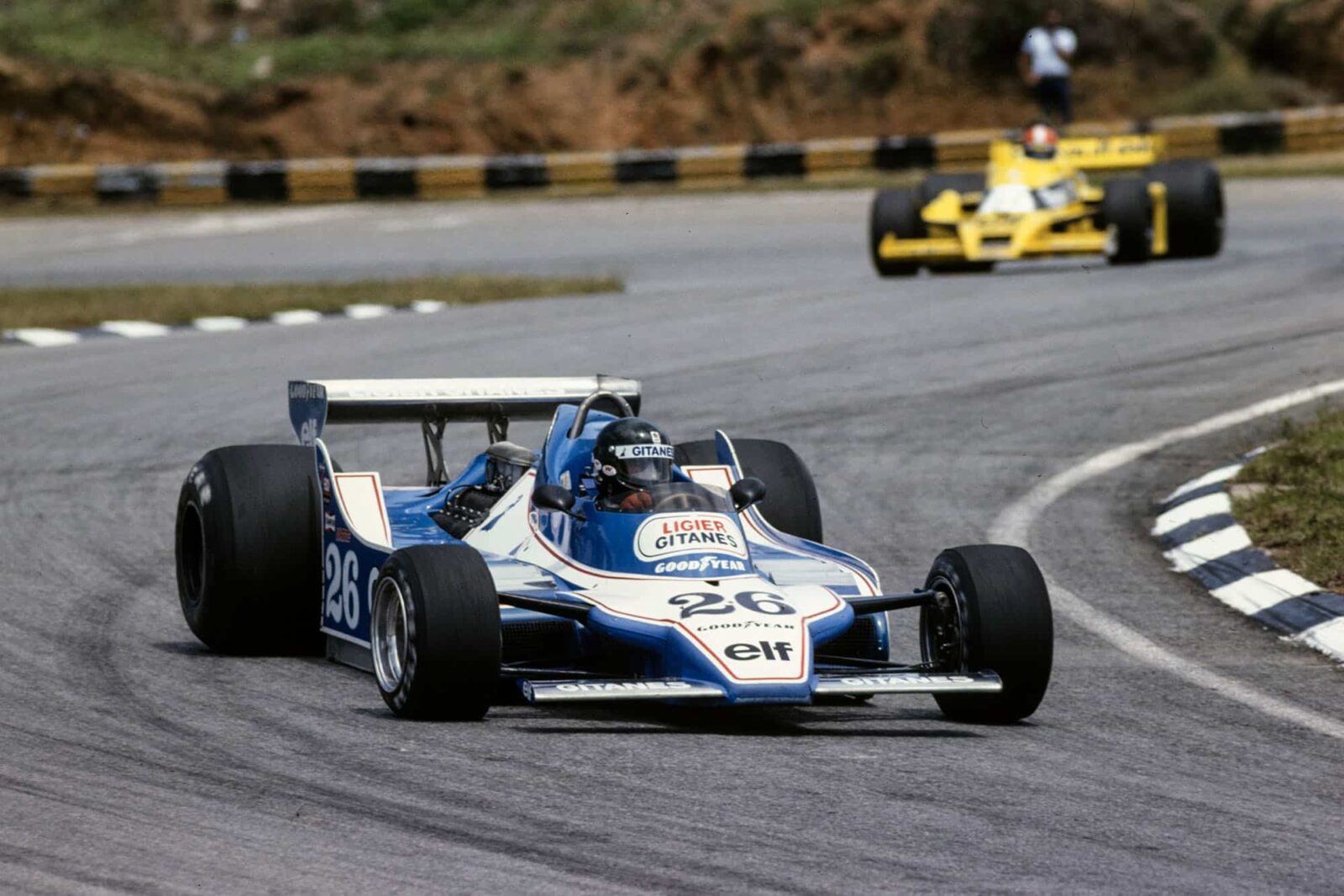
Jacques Laffite made it two in a row for Ligier at Interlagos
Motorsport Images
Ligiers in formation
Sao Paulo, February 4th
Two weeks after the Grand Prix season opened at Buenos Aires, the Formula One teams moved north to the spectacular 4.946-mile Interlagos circuit at Sao Paulo to where the Brazilian Grand Prix returned this year after being held at Rio-de-Janeiro for the first time in 1978. For the motor racing enthusiast there is no comparison between the two circuits, for while the Rio track is a tight, flat and boring little facility, Interlagos is spectacular, demanding on both car and driver, with plenty of very fast and slow comers wound into its length. Since Formula One cars last raced there in 1977 there has been an effort to resurface some of the more “troublesome” corners, but the ravages of the weather have taken their toll and the general consensus of opinion this year suggested that Interlagos was bumpier than ever before.
Whilst the hard-working mechanics toiled away unpacking and preparing their charges which had been flown up from Argentina, there was drama and argument going on away from the race circuit. Following the first corner accident in the Argentine Grand Prix, the stewards of that race had convened an inquiry and M. Jean-Marie Balestre (President of the Federation Mondiale du Sport Automobile, the new title assumed by the CSI at the start of 1979), made it quite plain that disciplinary action would be taken if a driver was found to be responsible for the accident. Eventually an inquiry was held on the Wednesday prior to the Brazilian race in Sao Paulo, the whole tenor of the proceedings taking on a distinctly unhelpful air when nobody from McLaren Racing was invited along. It was clear that the inquiry was examining John Watson’s role in the affair and, whilst they were not obliged to ask any representative of his team along to the inquiry (or even take evidence from Watson himself) according to the international rules, because they were only considering imposing a fine and not a suspension or disqualification, it would have been helpful to FMSA/FOCA relations if they had done so. Eventually they came to the conclusion that Watson was to blame for the accident, having run round the outside of Scheckter’s Ferrari and then collided with the Italian car as he attempted to cut back into line. A fine of 10,000 Swiss francs was imposed on the Belfast driver and it was made clear that if he didn’t pay within 48 hours (again, sticking religiously to the rule book) then he would not be permitted to start the Brazilian race. What followed next was a massive “who runs motor racing” row, a thin veil of politeness masking some pretty strong feelings on each side of the argument. What does seem clear is that, in his haste to put the motor racing world to right, M. Balestre has acted in a provocative and rather uncompromising manner; just the sort of way to provoke stern reaction from the part-time “small print” men within FOCA’s ranks, who were “running” the race in the absence of a sponsor just as they did at Hockenheim last year. All through the weekend there was an underlying feeling of discord and annoyance, but this fortunately evaporated into the background once 26 racing engines were fired up for an afternoon of unofficial testing on the Thursday prior to the race.
Since Buenos Aires there had been a great deal of technical activity. Lotus had flown out revised rear suspension uprights for their 79s to use with Goodyear’s bigger rear tyres; Brabham had devised modified fuel and oil systems for the new devised modified fuel and oil systems for the new BT48s in addition to modified skirts for the side pods; Wolf had abandoned their clutch-operated impellor which cooled the oil radiators, remounting the coolers on extended side pods and Ferrari had flown out another T3 (chassis 034) for Villeneuve to use as his race car. Scheckter’s accident-damaged 035 was repaired with more ease than expected, Arrows built up a replacement chassis for Patrese round monocoque 04 and Rebaque’s team rebuilt the rear end of his Lotus 79/1 after the rocker mounting point breakage in Argentina.
Jabouille opted to use the spare Renault RS01/02 as his race car while Jan Lammers was obliged to take over the spare Shadow DN9/3B after crashing his usual car (2B) very badly during the unofficial test session on Thursday. There was plenty of work in the McLaren garage on Thursday night as well, for Tambay went off on a very fast corner and knocked a couple of corners off his M28. Some sterling work got the Frenchman’s car repaired in time for the first official practice session on Friday morning.
Qualifying
During official Goodyear tyre testing last December, both Andretti and Watson had comfortably recorded time in the mid-2 min 27 sec. bracket for the 4.9-mile circuit and it was obvious that James Hunt’s official lap record of 2 min. 30.11 sec. would be improved upon by most competitors. However it was the French Ligier team which totally dominated practice at Interlagos with Argentine winner Jacques Laffite actually setting the time for pole position during the first 90-minute spell on Friday morning. Reflecting just how well Ligier have got all their technical “variables” under control, Laffite was able to record his 2 min. 23.07 sec. best within an hour of the start of that session. For his rivals, it must have been the most profoundly demoralising sight imaginable. In the second session Jacques simply didn’t bother to take his car out; he sauntered casually up and down the pit lane watching everybody else’s progress with a big grin on his face. Then, on Saturday afternoon, when the cool conditions of the previous day had given way to much warmer weather, he simply took the team spare JS11/01 out for a few laps to check it over. Really, there was no realistic competition for this well-organised combination.
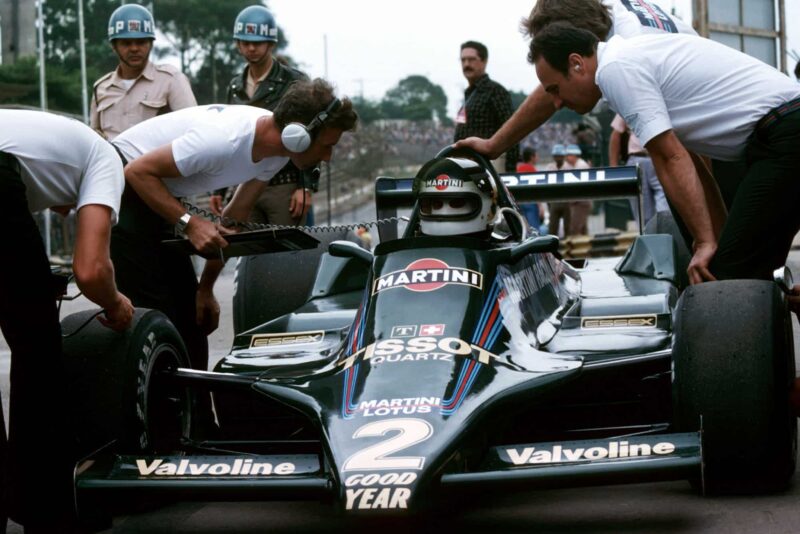
Carlos Reutemann qualified 3rd for Lotus
Motorsport Images
In fact, Depailler reckoned he could have taken pole position away from his team-mate if the weather hadn’t become hotter on Saturday. His Friday best was 2 min. 23.99 sec., which stood him in as second quickest for the starting grid, but he failed to improve on the morrow. Depailler’s car had been fitted with modified rear body cowlings on the first day and the driver felt that these upset the car’s fine balance, so he reverted to the same configuration as Laffite’s machine for Saturday.
It seemed as though the two Ferrari T3s would provide the strongest opposition to the Ligiers at the end of the first day, Villeneuve taking over his spare car (the one he used in the Buenos Aires race) to record a very promising 2 min. 24.34 sec. best which was a fraction quicker than his team-mate Scheckter who confessed to a spin on one of the slower corners. It was noticeable that Michelin’s qualifying rubber would only just about last for a single flying lap round Interlagos and the two Ferrari drivers could be seen cruising round gently when the track was crowded, picking their moment to attempt a really worthwhile lap time.
Although it was much warmer on Saturday, that did not deter Team Lotus from launching a massive effort to displace the Ligiers from the front row of the grid. Friday had been a troubled day for Reutemann as his race car had broken a valve spring in the first session and he had missed a lot of time while the mechanics readjusted the cockpit of the spare to accommodate the tall Argentinean as it had originally been prepared for the World Champion’s potential use. Reutemann spent the second session in the spare and improved to 2 min. 25.91 sec., while Andretti’s best for the day was 2 min. 25.33 sec. which he recorded in the first session. There was an awful lot of delicate chassis tuning going on in the Lotus pits with changes of rollbars, springs and dampers. Then, during the final hour, Reutemann reached what he felt was pretty well his personal limit (given the amount of qualifying rubber available) and brought his Lotus 79 into the pits after recording a 2 min. 24.15 sec. best to snatch inside position on the second row of the grid and make the Ligier team raise their eyebrows a little. Andretti stayed out right to the end of the final session and, aided by a fresh set of qualifying tyres on the back and the front tyres which Reutemann had used for his “quick one,” all but matched his team-mate with a good 2 min. 24.8 sec.
Neither Ferrari improved on Saturday, so they monopolised the third row of the starting grid with Jean-Pierre Jabouille proving that the Renault could certainly pose a threat to the establishment with a 2 min. 24.85 sec. for the inside place on the fourth row. Jabouille decided that blanking off the oil radiators with aluminium sheeting slightly improved the aerodynamic balance of the French turbo V6 car. Arnoux, handicapped by the late delivery from France of a fresh engine for his car, could only record a 2 min. 26.46 sec. best which was nevertheless extremely respectable for a driver with such modest experience of Formula One.
In the Tyrrell camp Jarier was feeling very off colour and couldn’t inspire himself to repeat his Interlagos form of 1975 and 76, so the responsibility for spearheading his team’s attack fell upon Pironi’s shoulders. The young French driver rose to the occasion admirably and, despite complaining about a slight tyre imbalance on Friday, returned a 2 min. 25.16 sec. lap, eighth quickest overall. Jarier noticed that his Tyrrell’s steering seemed to be tightening up as he negotiated the faster corners at Interlagos and it was only discovered at the end of practice that the 009’s monocoque was starting to come unstitched at the front, probably a long-term result of his Buenos Aires practice accident. Either way, his best lap of 2 min. 27.89 sec. did not amount to a great deal.
The Brazilian Grand prix was a notable occasion for the local Fittipaldi family, for this marked the debut of their brand new ground effect car on which Ralph Bellamy had been working since last April. The result of his efforts is a strikingly good looking racing car with a conspicuously slender fuselage and side pods mounted distinctively far back and extending between the rear wheels and the engine. Front and rear suspension are tucked tightly inboard, in keeping with the current trend, while exhausts are in effect reversed and come out just ahead of the rear wheels on either side of the car. Fittipaldi drove the car in untimed testing, briefly tried it during the first official Friday session and then reverted to his tried and tested F5A design for the remainder of practice and the race. The team was confidently hoping for a good result on home ground and, although they got themselves mixed up on differing tyre compounds during the final hour, E. F. emerged with a best of 2 min. 26.35 sec. which was ninth fastest.
The modifications carried out by designer Harvey Postlethwaite to his new Wolf WR7 design gave James Hunt a rather more encouraging time in Brazil than he had enjoyed in Buenos Aires. Although the Englishman was still complaining about acute oversteer, at least the car seemed more predictable than it had been at the previous race. Hunt seemed to be displaying a lot of his previous fire and popped in a 2 min. 26.37 sec. best in the final hour although he was very fortunate indeed not to be sitting on the sidelines for all of that last session. On his very first lap the gear lever came away in his hand and the Wolf slipped into neutral. He coasted to a halt at the side of the track and, with commendable promptness, jumped out of the cockpit and fumbled beneath the car, forcing it into one gear. He then climbed back in, persuaded the marshals to help him with a push start and roared off back to the pits for a permanent repair to be effected!
Flanking Arnoux on the eleventh row of the grid was Niki Lauda in his Brabham BT48, the Austrian getting to grips with the willing power of the new Alfa Romeo V12 engine and making some worthwhile progress. There is still obviously a lot to come from this new design and Gordon Murray expressed himself extremely impressed at the way Lauda simply gets down and works steadily at a problem rather than throwing up his hands in despair and giving up. Cautiously confident about his race prospects, Lauda recorded a 2 min. 27.57 sec. lap during Friday’s second session. Overnight various chassis and aerodynamic modifications were made which seemed to hold up the new Brabham’s progress during Saturday’s timed session and Lauda spent all his time doing single laps and stopping at the pits, so he was not credited with a flying lap time in the final session.
As Piquet’s BT46 had been reduced to scrap in the Buenos Aires accident, the young Brazilian was designated to use BT48/1 for his home Grand Prix. Piquet didn’t feel like practising on Friday because his feet were still badly bruised but he staggered round for half a dozen brave laps on Saturday to record a 2 min. 31.64 sec. which whilst not startling, at least rewarded his doggedness with a place on the grid.
After the sixth row of the grid one moved into an area of complaints or dissatisfaction. Alan Jones, using FW06/005 gamely got to grips with Interlagos to record a 2 min. 27.67 sec. lap but there was nothing good happening to the McLaren team and there were some very long faces to be seen in their garage. Watson wasn’t able to make the M28 work over the bumps and ripples of Interlagos, complaining that it was not possible to balance it out and it wore its tyres harshly, whilst Tambay was hardly on the road for long enough to form an impression. After his M28 had been repaired on Thursday night he slid into a guard-rail on Friday, perhaps after a front tyre deflated, and although the damage was relatively minor there were no more M28 spare parts available. Thus Tambay had to take over the old M26/5 for Saturday practice and even then managed to spin it over the kerbing at one corner, ripping off a radiator cowling and dislodging the nose section as he did so. Fortunately the car was not badly damaged and was repairable in a short time.
The end result for McLaren was Watson on the outside of the seventh row with a 2 min. 27.82 sec. best in the new M28 and Tambay on the outside of the ninth row on 2 min. 29.39 sec. Regazzoni plugged round in unspectacular style to record an uncompetitive 2 min. 28.88 sec. while both the Arrows drivers were very glum indeed. Neither Patrese (2 min. 28.08 sec.) nor Mass (2 min. 29.42 sec.) could adjust their cars properly for the circuit and when they did try to adjust them, more often than not it made no difference at all to their behaviour. There could be some small sliver of consolation that nothing was going well in the rival Shadow camp either, for on Friday de Angelis slid off the circuit to repeat Lammers’ accident of Thursday afternoon, bending his Shadow DN9/1B extremely badly. To the credit of his mechanics, the car was stitched back together again in time for Saturday, but it stretched the team’s supply of spares in doing so. The young Italian then rewarded their efforts with a 2 min. 30.29 sec. lap which got him comfortably on the grid and was comfortably faster than the rather unsettled Lammers.
Bringing up the rear was Daly’s Ensign, which only began to handle well when Goodyear produced some of the smaller rear tyres and which missed the second session completely owing to a gearbox breakage, and Stuck in the precarious looking ATS. Daly’s best was 2 min. 31.78 sec. which simply reflects just how difficult things are without a ground effect machine. Stuck, who hadn’t been able to test at Buenos Aires as planned after the race, scraped in with a 2 min. 31.27 sec. after a host of minor problems. Non-qualifiers for the 24-car grid included Rebaque’s Lotus (perhaps surprisingly) and Merzario’s troubled special.
Race
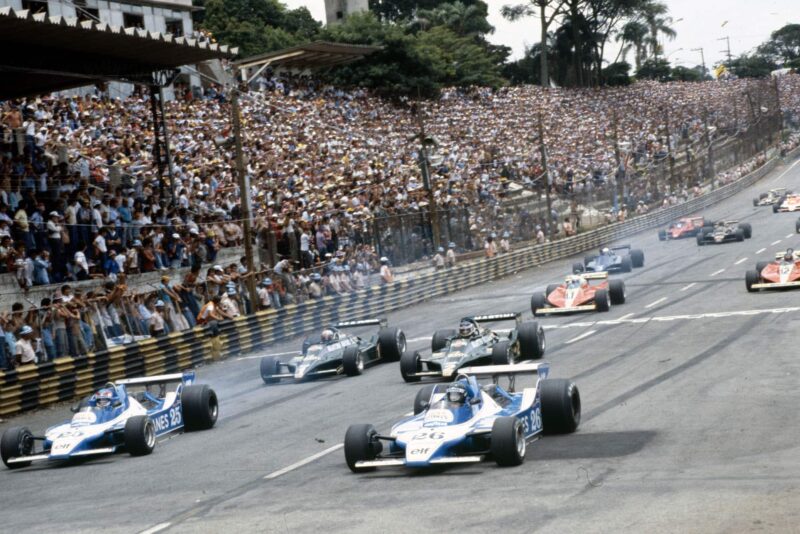
Tyres smoke at the cars pull away
Motorsport Images
There was a slight kerfuffle during Sunday’s untimed warm-up when Laffite stayed out for four laps after the chequered flag; something that seemed to send Bernie Ecclestone and Robert Langford into a right old paddy on the start/finish line. When Laffite finally came in, Ecclestone got really shirty with the Frenchman until it was pointed out to the Brabham chief just who was running the motor race. The whole affair seemed quite remarkable in retrospect, for after the race there seemed to be far more pressing matters prevailing (notably Reutemann’s push start), a far more serious matter which provoked a far less hysterical reaction.
Minor problems in that warm-up session included Scheckter’s Ferrari going off song (so a hurried engine change was carried out) plus suspensions wilting on both Patrese’s Arrows and Stuck’s ATS. Andretti’s Lotus briefly caught fire at the rear end just prior to going out on its warming up lap, but this was quickly doused. However there was more ill-fortune awaiting the Lotus drivers when they arrived to take up their places on the dummy grid. Andretti’s caught fire again and Reutemann’s would not start, so there was a scramble with extinguishers on one side of the road and compressed air bottles on the other. Andretti’s 79 briefly disappeared behind a wall of extinguisher powder, but this was quickly dusted down and he set off on the parade lap with the rest. Reutemann’s car steadfastly refused to start, so he was given a push and sent chasing off after the grid which was heading around its parade lap in slow formation behind the two Ligiers. Overtaking most of his rivals to re-position himself on the inside of the second row, Reutemann inadvertently infringed another “paragraph of the rule book” which apparently forbids this sort of overtaking. Thus, by the time the Argentinian had got into his starting position, he’d technically infringed to regulations. What a shame Formula One has become so hide-bound by what appear so many petty rules which are sometimes enforced with such apparent vindictive delight!
One casualty of the parade lap was Jarier’s Tyrrell 009, grinding to a halt with electrical failure, while the remaining 23 runners edged up to take the starting signal. As the lights turned on the gantry over the startline turned to green, Laffite made a copybook getaway to lead into the fast left-hander after the pits with Reutemann diving through into second place from Depailler and Andretti. At the bottom of the long hill, Depailler sped past the Lotus with contemptuous ease to take over second place and Andretti nipped through the same gap, so Reutemann was pushed back to fourth within a mile of the start!
Up back into the infield they came, round the tight hairpins and out onto the start/finish straight with Laffite and Depailler ahead pursued by Andretti, Reutemann, Scheckter, Fittipaldi (look at his grid position!), Pironi, Villeneuve, Lauda, Jones, Patrese, Hunt, Regazonni, Tambay, Mass, Arnoux, Watson, de Angelis, Piquet (who had started the race on soft tyres and half empty fuel tanks as he realised his battered feet would not last the distance), Stuck and Lammers. Bringing up the tail end was Jabouille who had stalled his Renault on the line and was now embarking on a fine climb back through the field.
By the end of the first lap the two Ligiers were edging away from the Lotus twins and Hethel’s challenge took a big dive next time round as Andretti pulled off into the pit lane. The cause of the small fire wasn’t, as his mechanics had hoped, a drip of fuel split from a spray bottle, but a small hole in the metering unit diaphragm. This caused the engine to lapse onto six cylinders, from which point Andretti’s race was doomed.
This retirement promoted Fittipaldi to fifth place, the Brazilian really flying in front of his home crowd. As they hurtled down the hill after the pits E. F. rushed right up on Scheckter’s tail and slipped inside the Ferrari at the end of the straight, such to the frenzied delight of his fans in the crowd. But by this time everything else was starting to look a little irrelevant in the wake of the two Ligiers – even though Laffite was later to complain of acute understeer throughout the race and Depailler of acute oversteer.
Further down the field there was trouble brewing for the two Brabham-Alfas as Lauda, after a promising start, found that his gear selectors were causing him trouble every time he tried to find fourth and fifth ratios. He dropped back and it didn’t take long for the enthusiastic Piquet to come up and pass him. Unfortunately the Brazilian driver’s sheer zeal wasn’t matched by his experience and he threw himself gamely into a battle for 12th place with the experienced Regazzoni. Going into one of the right hairpins, Piquet thought he saw a gap and moved to go through it only for Regazzoni to chop across sharply. Piquet really hurt his right foot as he slammed on the brakes, but he couldn’t slow the Brabham sufficiently to prevent it colliding with the back of the Williams. Regazzoni continued on his way unscathed, but Piquet trailed into the pits for good with the nose section of the Brabham askew and a surfeit of personal pain. At the same time, Lauda’s gear-change became so badly deranged that the Austrian also retired.
As the two Ligiers pulled effortlessly away from Reutemann, Hunt soon encountered problems as he felt the steering go funny on his Wolf. With six laps completed he came in for attention and, although he subsequently managed another lap, the Wolf’s steering rack was coming adrift so he couldn’t motor any further.
Reutemann was chasing the Ligiers gamely, but he was starting to feel the 79 understeering too much for his liking in fast corners and twitching to oversteer in the slower turns. Consequently he was working away harder than he would have liked to and this erratic handling gradually dropped him away from the leaders although he seemed able to hold Fittipaldi at four or five lengths behind him. Scheckter was falling away from this bunch and being pressed by the determined Pironi, anxious to score a good result after his Buenos Aires disappointment. Half-way round the sixth lap Pironi slipped his Tyrrell is front of the Ferrari, but immediately got caught up in the excitement of his success and momentarily let his concentration lapse as he braked for the tight infield hairpin which had claimed both the Shadow drivers during practice. In a trice, the Tyrrell had spun three times, just missing the guard-rail on the outside of the corner. It was a really close thing but Pironi wasn’t daunted and selected second gear almost before the car had stopped. This little excursion cost him a couple of hundred yards and the wily Scheckter slipped by again on the inside of the corner.
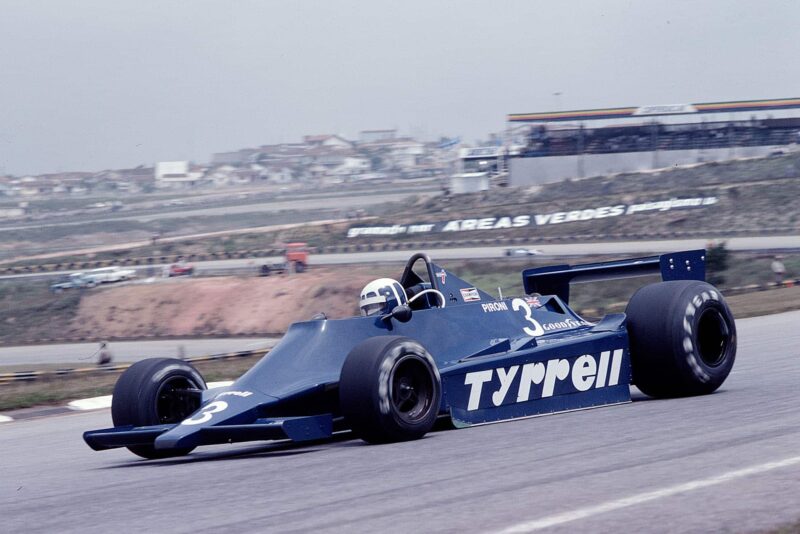
Didier Pironi finished an impressive 4th for Tyrrell
Motorsport Images
Meanwhile Jabouille’s Renault was enacting an impressive chase through from the back, cutting his way back to 13th by the end of the sixth lap. He was close on Tambay’s heels when the McLaren driver tried to force his M26 on the inside of Regazzoni’s Williams as they swung into a climbing left-hand corner. The Frenchman might have known better than to tackle the Swiss in such circumstances and the two cars collided, Regazzoni’s simply spinning while Tambay completed a really demoralising weekend by wrapping up the McLaren in the catch-fencing complete with one battered front corner.
Regazzoni made a precautionary pit stop, but continued at the tail end of the field, while Jabouille made two places with no effort on his own behalf. On lap ten Pironi started attacking Scheckter again, and with the Ferrari’s hard compound tyres wearing badly and picking up a surfeit of unwanted “gunge” from the track surface, it wasn’t too hard for the Tyrrell to slip through halfway round the eleventh lap. From that point onwards Pironi pulled away from the South African and took care not to repeat his earlier indiscretion. Fittipaldi had dropped back slightly from the third placed Reutemann as he felt a vibration building up at the back of his car when he accelerated hard out of tight corners. But he maintained fourth place until just after the start of the 21st lap when he slowed suddenly, feeling a rear wheel to be coming loose. As he had only just passed the pits when this happened, he was faced with the best part of five miles to crawl back to the pits for attention.
This little drama meant that the race order was now Laffite, Depailler, Reutemann, Pironi, Scheckter, Villeneuve and Jones. Then came the two dejected Arrows drivers, Patrese and Mass, both struggling with badly wearing tyres and erratic handling. Patrese was eventually to ease off so much to conserve his tyres that Mass went through ahead of his team-mate, but they were both nursing their mounts home by the end of the race.
Fittipaldi resumed in 12th place after finding that both his rear wheels had worked loose; a fresh set of tyres all round was slapped on when he stopped. Villeneuve also pulled in for fresh tyres at the end of lap 21, the French Canadian driver remarking that it was rather like driving on ice as his Michelins had picked up so much “gunge.” He resumed 11th, but Scheckter stayed out until lap 27, only for a slow tyre change to drop him behind his team-mate when he resumed. The Ferrari troubles had helped Jabouille to rush back to sixth place behind Jones, but the Renault too was in dire need of fresh rubber and stopped for a change on lap 29. Arnoux had vanished from the fray a lap earlier when he spun his Renault to a terrifying, but fortunately undamaged, halt on the flat-out left-hander after the pits, a corner taken by the French V6s in sixth gear!
By lap 30 the order was Laffite, Depailler, Reutemann, Pironi, Jones and Mass: John Watson was still struggling round gamely behind the fast-recovering Ferraris, his McLaren M28 swinging from understeer on left-handers to oversteer on right-handers, behaviour which was slaughtering his tyres. On lap 31 Jones’ unobtrusively efficient drive came to an end when fuel vaporisation began to make the car misfire badly. He came in to see if anything could be done, water was poured over the fuel pump and he went back into the race. But such treatment was to no avail and the disappointed Australian was in for good at the end of 32 laps.
From that point onwards there was little interest left in the race, the two Ligier JS11s coming home to an impressive 1-2 victory which left some of their rivals scratching their heads and wondering just what the Frenchman had done right that they hadn’t done. The answer, of course, is that it was a question of what the others “had done wrong” as the setting up of a Grand Prix car is a question of combining many variables to best effect. Ligier had “mixed the recipe” just right for Interlagos as they had done for Buenos Aires and there were a lot of enthusiasts grinning broadly at the end of the race as Laffite came across the line waving his right arm in the air with delight, just over five seconds ahead of his team-mate.
Reutemann finished a thoughtful third ahead of the promising Pironi, while Villeneuve and Scheckter were lapped in fifth and sixth places after their pit stops. Mass was a struggling seventh ahead of the similarly afflicted Watson, Patrese and Jabouille who was pleased that his Renault had suffered no mechanical problems at all for the very first time. Fittipaldi fought back to tenth ahead of de Angelis, Daly, Lammers and the trailing Regazzoni, while Stuck stopped with a broken steering wheel spoke after an earlier pit stop to add extra fuel in an attempt to cure misfiring.
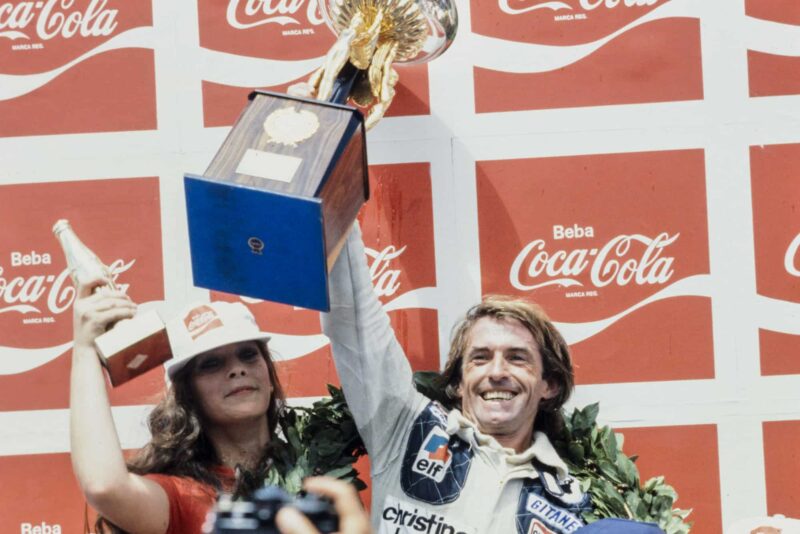
Laffite celebrates his second win of the season
Motorsport Images
An initial protest over Reutemann’s behaviour on the parade lap was dismissed out of hand and then Ferrari protested the results on the basis of the Lotus’s push start. It seems certain that the whole matter will be referred to the Sport’s rulers in Paris, so it may be some months before we really know who finished third and below at Interlagos. But the one certain fact is that the Ligiers finished in 1-2 formation; and that was about the only certain fact about this year’s Brazilian Grand Prix! – A. H.
